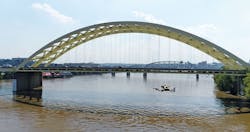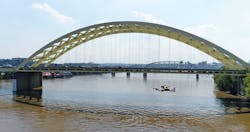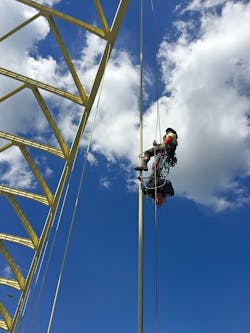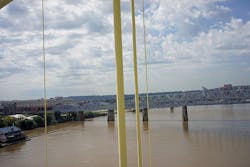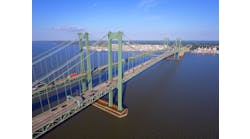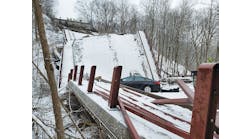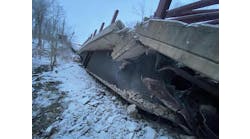Comparative study of hands-on vs. UAS inspection techniques on Big Mac Bridge looks to aid maintenance and safety
By: Alicia McConnell, P.E. and John Zuleger, P.E.
In September 2016, Michael Baker International performed a routine and hands-on fracture-critical inspection of the Daniel Carter Beard (Big Mac) Bridge, which carries I-471 and more than 100,000 vehicles each day between Newport, Ky., and Cincinnati, Ohio.
A full-length inspection of the bridge’s hanger cables was never performed, or required, prior to this 2016 inspection, more than 40 years after the bridge originally opened. Inspectors devised rope access techniques to successfully inspect the cables, which required arduous climbing. The bridges were again scheduled for inspection in 2018, but this time with the caveat that the cables would not require full-length hands-on inspection. However, to advance the practice of inspection, an unmanned aerial system (UAS) solution was proposed to scan the cable lengths. Data collected would not only aid in the inspection itself, but provide a comparative analysis between hands-on and UAS collection methods.
The team set out to determine: Can UAS scanning deliver a level of detail comparable to hands-on methods for easily accessible structural elements such as cables?
Intricate or congested areas around connections are often difficult for a UAS to scan completely; however, open elements are an excellent opportunity to employ UAS technology and the perfect complement for rope access. Rope access excels in congested areas due to the jungle gym of climbing opportunities. However, deploying long rope rappels can be time-consuming compared to simply inspecting connection locations while climbing without the use of long ropes.
The team’s Falcon 8+ was selected to capture the length of the cables in between the top and bottom connections.
The usual way
Michael Baker’s team of eight (12 in total) Society of Professional Rope Access Technicians (SPRAT), including four level-3 site supervisors, devised a plan to use two power seats during the 2016 hands-on inspection of the cables. Power seats are motorized winch ascenders that allow inspectors to optimize mobility by easily ascending/descending the cables. Inspectors can efficiently traverse a bridge while inspecting vertical members by alternately rappelling and ascending cables. Inspecting the 88 cables across both bridges via rope required approximately 10 days. The results revealed deleterious effects occurring at connection locations of the cables with only minor issues such as paint loss occurring along the length of the cables. It was determined, in collaboration with officials from the Kentucky Transportation Cabinet (KYTC), that the effort would not be repeated in future inspections after KYTC officials experienced the climbing conditions firsthand when they rode the power seats to the top of the arches.
A new way
In effort to reduce the efforts of long rope work in 2018, the team implemented UAS technology in collaboration with Intel. Located in the heart of Cincinnati, the Big Mac bridge is adjacent to the historic Lunken Airport. The Federal Aviation Administration (FAA) deliberated approximately 120 working days before granting access. Michael Baker’s UAS program consists of 40 Part 107 certified pilots and more than 30 airframes across the nation. Teams are ready for rapid deployment usually within a four-hour window, if necessary, for emergency responses. However, this inspection required a more methodical approach as several components would be occurring simultaneously. It is important to recognize that UAS is a sophisticated tool that, when applied appropriately to each structure type, can provide many advantages. Depending on the investigation required, a lane closure may be essential for the pilot and sensor operator to safely perform flight operations. Often an Under Bridge Inspection (UBI) vehicle is required to investigate the floor system, and pilots can take advantage of it by not requiring additional impacts to traffic.
The UAS team’s primary mission was capturing the length of the cables in between the top and bottom connections. Although Michael Baker’s cache of UAS airframes includes the Phantom 4 Pro and Inspire 2, the team’s Intel Falcon 8+ was selected for this mission. The eight-rotor airframe carries a 36-megapixel camera capable of 180° of view. This allows inspectors to view elements straight above the airframe. The high-resolution camera provides highly detailed still images at 15-20 ft from the element, and image quality is retained when zooming in on the finer details of that element. Flight times (including battery management and data management) averaged eight minutes per cable; the actual flight took about two minutes per cable to scan both sides. Pilots scanned the interiors and exteriors of the cables from the safety of an on-ground lane closure. Flight challenges came in many forms. Vehicular traffic creates a wind-shedding effect with significant gusts altering flight stability. The bridge itself imposed magnetic interference challenges, which pilots navigated while in flight. Airspace authorization also was a logistical consideration at this site.
The SPRAT team devised a plan to use two power seats during the 2016 hands-on inspection of the cables.
Making the comparison
The team also developed a secondary mission to create an in-situ 3-D model of the bridge. Several flights were choreographed around the bridge to gather thousands of photos to be combined into a photogrammetric mosaic. The flight process for modeling the structure only took four hours with less than an hour for the planning phase utilizing Intel’s Mission Control software. This software minimizes manual piloting and allows the autonomous systems to guide the data capture. Intel’s team post-processed the data to provide the Michael Baker team with a real-world digital representation of the bridge. A post-processing baseline was established of approximately 10-15 hours for stitching photos of a complex structure using Intel Insight software. The inspection team examined the myriad of data existing between the cable stills and the 3-D model to compare to the 2016 inspection.
It was evident from the comparison that the 2016 inspection documented numerous deficiencies along the cables; it should be noted that complete records traditionally rely on inspectors’ photos and notes. While thoroughly documenting each location of deterioration, every instance of paint loss and minor deficiencies are not necessarily catalogued with a photo. The UAS scans from 2018, on the other hand, provided a complete record of every inch examined. Limitations are predominantly near areas where piloting the UAS into complex spaces is difficult. The sloping bottom side of the arch interface with the top of the connection, for example, is difficult for the UAS to observe, simply because the UAS access to that particular angle is inhibited by the structure. However, when combined with rope access, the two are synergistically able to complete the task. The UAS minimizes man-at-risk hours for easily observable cable elements, and the rope access team can focus its effort on more critical and elaborate connections.
UAS detection of deficiencies varies depending on the lighting and sun angle, condition of the element, camera capabilities, and other factors. The pilot and sensor operator can overcome these challenges with several tools. The easiest solution is to adjust the camera aperture, exposure and f-stop for optimal detection of a deficiency against its base element. When reviewing high-resolution images in post-processing, the limitations of zooming in on a digital image is a function of the pixelization of the image.
For Big Mac, hairline cracking was easily observed in the paint of the cable as exhibited in the pictures. This threshold gave inspectors confidence the system was calibrated correctly, as this is typically the limit for the human eye. The detection process involves the pilot and sensor operator collecting and observing data in real time on a tablet-sized monitor. The sensor operator flags obvious deficiencies, and then a two-person inspection team reviews the data on a larger screen for any additional issues. During the review, no additional deficiencies were noted outside of the connection locations from 2016 to 2018. Previously detected areas were compared between the two years and subsequently had progressively deteriorated even further. Areas noted in the 2016 report were verified independently in the 2018 UAS data, i.e., inspectors were not scavenging in the field for known items.
The 3-D model produced will provide future inspectors with a high-level set of comparative data for time-dependent structural health monitoring. While the obvious benefit of the close-up images is deficiency detection, the images gathered for modeling purposes are not as detailed. Images gathered for the model do exhibit the global condition of the structure for stakeholders to consider allocation of funding for maintenance. Erin Van Zee, P.E., KYTC’s NBIS Program Manager, opined, “If we can collect data today and come out in three years, five years, 10 years and put these models together and help program funds for the future to use taxpayers’ money more efficiently, we can use our time more efficiently.”
Modeling also can benefit engineers performing a load-rating analysis. A load rating considers the current condition of a structure and through engineering analysis determines the theoretical load-carrying capacity. A 3-D model allows a load rater to consider various areas of deficiencies and take a closer look by examining the base images used to make the model. The model also can provide engineers with details such as fit-up of structural elements crucial to an analysis where plans may not exist. Direct inspection application of a model is still developing, but several ancillary benefits exist for engineers to take advantage of these sophisticated tools.
UAS scanning delivers levels of detail comparable to hands-on methods for structural elements such as cables.
Verdict
Overall, there were many tangible benefits of applying UAS technology to this type of structure. It was demonstrated in this case study that UAS scanning delivers levels of detail comparable to hands-on methods for easily accessible structural elements such as cables. Additionally, the 2016 inspection required approximately 10 days of strenuous climbing in high heat. In comparison, the 2018 combined-access approach required five days, and although still a hot September, man-at-risk hours were reduced by nearly 50%.
Challenges for a combined-access team still exist, but the advantages of combined-access solutions provide competent data, mitigate risk, provide complete historical data for future reference, and minimize the impacts and costs to stakeholders.
About The Author: McConnell is UAS program manager at Michael Baker International. Zuleger is UAS technical manager and rope access program manager at Michael Baker International.
